Cultural Theory: Comparative Analysis of UK and Pakistan Cultures
VerifiedAdded on 2023/03/23
|13
|4724
|77
Report
AI Summary
This report delves into the application of Grid-Group Cultural Theory to compare and contrast the cultural landscapes of the United Kingdom and Pakistan. It begins with an introduction to the theory, outlining its core concepts and dimensions, including fatalism, collectivism, individualism, and egalitarianism. The research methodology employed a mixed-methods approach, combining qualitative and quantitative techniques, including semi-structured interviews with university staff in both countries. The analysis highlights significant cultural differences, such as the prevalence of individualism in the UK versus collectivism in Pakistan, and the implications for social relationships and organizational dynamics. The report also examines the role of cultural prejudices and the need for cross-cultural management strategies. The findings underscore the importance of understanding cultural nuances to foster effective communication and collaboration in diverse environments, offering valuable insights for leadership management and cross-cultural understanding. The report emphasizes the need for further research and adaptation of cultural practices to promote social harmony and address inequalities.

Running head: CULTURAL THEORY 1
Cultural theory
Cultural theory
Paraphrase This Document
Need a fresh take? Get an instant paraphrase of this document with our AI Paraphraser

CULTURAL THEORY 2
Table of Contents
Grid-Group Cultural Theory: an introduction............................................................................3
Research methods.......................................................................................................................4
Analysis......................................................................................................................................5
Differential cultural aspects between UK and Pakistan.............................................................6
Table of Contents
Grid-Group Cultural Theory: an introduction............................................................................3
Research methods.......................................................................................................................4
Analysis......................................................................................................................................5
Differential cultural aspects between UK and Pakistan.............................................................6
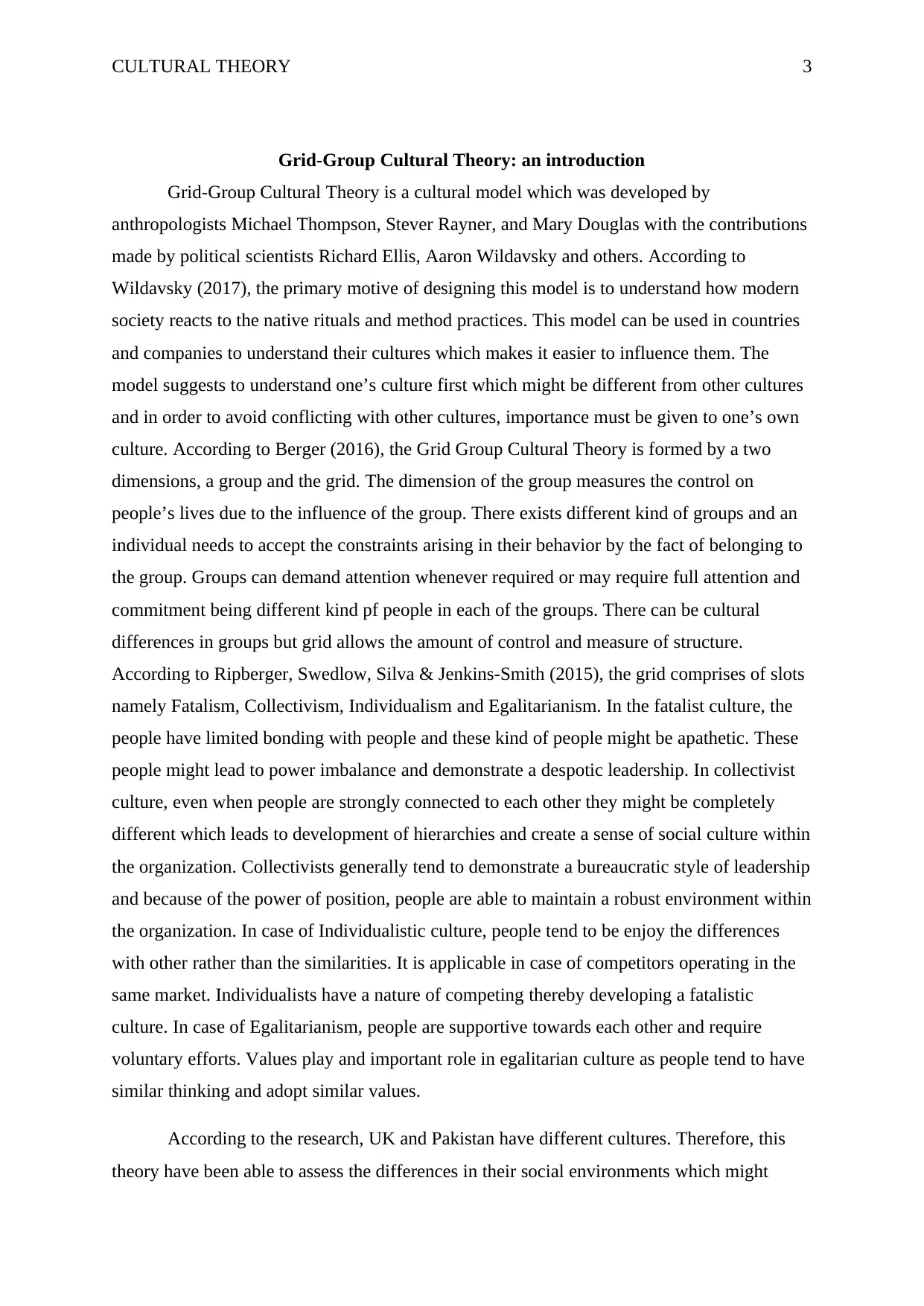
CULTURAL THEORY 3
Grid-Group Cultural Theory: an introduction
Grid-Group Cultural Theory is a cultural model which was developed by
anthropologists Michael Thompson, Stever Rayner, and Mary Douglas with the contributions
made by political scientists Richard Ellis, Aaron Wildavsky and others. According to
Wildavsky (2017), the primary motive of designing this model is to understand how modern
society reacts to the native rituals and method practices. This model can be used in countries
and companies to understand their cultures which makes it easier to influence them. The
model suggests to understand one’s culture first which might be different from other cultures
and in order to avoid conflicting with other cultures, importance must be given to one’s own
culture. According to Berger (2016), the Grid Group Cultural Theory is formed by a two
dimensions, a group and the grid. The dimension of the group measures the control on
people’s lives due to the influence of the group. There exists different kind of groups and an
individual needs to accept the constraints arising in their behavior by the fact of belonging to
the group. Groups can demand attention whenever required or may require full attention and
commitment being different kind pf people in each of the groups. There can be cultural
differences in groups but grid allows the amount of control and measure of structure.
According to Ripberger, Swedlow, Silva & Jenkins-Smith (2015), the grid comprises of slots
namely Fatalism, Collectivism, Individualism and Egalitarianism. In the fatalist culture, the
people have limited bonding with people and these kind of people might be apathetic. These
people might lead to power imbalance and demonstrate a despotic leadership. In collectivist
culture, even when people are strongly connected to each other they might be completely
different which leads to development of hierarchies and create a sense of social culture within
the organization. Collectivists generally tend to demonstrate a bureaucratic style of leadership
and because of the power of position, people are able to maintain a robust environment within
the organization. In case of Individualistic culture, people tend to be enjoy the differences
with other rather than the similarities. It is applicable in case of competitors operating in the
same market. Individualists have a nature of competing thereby developing a fatalistic
culture. In case of Egalitarianism, people are supportive towards each other and require
voluntary efforts. Values play and important role in egalitarian culture as people tend to have
similar thinking and adopt similar values.
According to the research, UK and Pakistan have different cultures. Therefore, this
theory have been able to assess the differences in their social environments which might
Grid-Group Cultural Theory: an introduction
Grid-Group Cultural Theory is a cultural model which was developed by
anthropologists Michael Thompson, Stever Rayner, and Mary Douglas with the contributions
made by political scientists Richard Ellis, Aaron Wildavsky and others. According to
Wildavsky (2017), the primary motive of designing this model is to understand how modern
society reacts to the native rituals and method practices. This model can be used in countries
and companies to understand their cultures which makes it easier to influence them. The
model suggests to understand one’s culture first which might be different from other cultures
and in order to avoid conflicting with other cultures, importance must be given to one’s own
culture. According to Berger (2016), the Grid Group Cultural Theory is formed by a two
dimensions, a group and the grid. The dimension of the group measures the control on
people’s lives due to the influence of the group. There exists different kind of groups and an
individual needs to accept the constraints arising in their behavior by the fact of belonging to
the group. Groups can demand attention whenever required or may require full attention and
commitment being different kind pf people in each of the groups. There can be cultural
differences in groups but grid allows the amount of control and measure of structure.
According to Ripberger, Swedlow, Silva & Jenkins-Smith (2015), the grid comprises of slots
namely Fatalism, Collectivism, Individualism and Egalitarianism. In the fatalist culture, the
people have limited bonding with people and these kind of people might be apathetic. These
people might lead to power imbalance and demonstrate a despotic leadership. In collectivist
culture, even when people are strongly connected to each other they might be completely
different which leads to development of hierarchies and create a sense of social culture within
the organization. Collectivists generally tend to demonstrate a bureaucratic style of leadership
and because of the power of position, people are able to maintain a robust environment within
the organization. In case of Individualistic culture, people tend to be enjoy the differences
with other rather than the similarities. It is applicable in case of competitors operating in the
same market. Individualists have a nature of competing thereby developing a fatalistic
culture. In case of Egalitarianism, people are supportive towards each other and require
voluntary efforts. Values play and important role in egalitarian culture as people tend to have
similar thinking and adopt similar values.
According to the research, UK and Pakistan have different cultures. Therefore, this
theory have been able to assess the differences in their social environments which might
⊘ This is a preview!⊘
Do you want full access?
Subscribe today to unlock all pages.

Trusted by 1+ million students worldwide
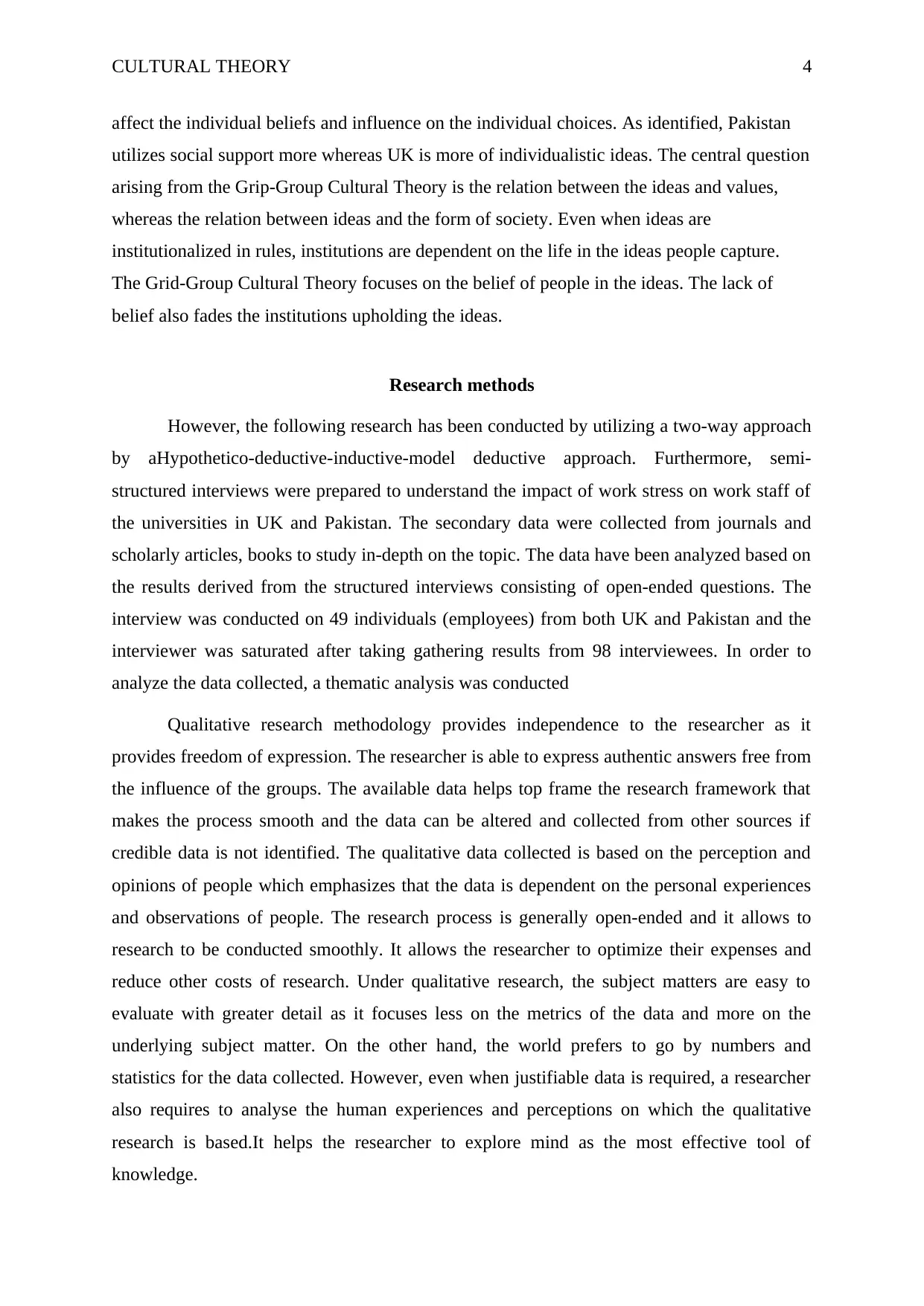
CULTURAL THEORY 4
affect the individual beliefs and influence on the individual choices. As identified, Pakistan
utilizes social support more whereas UK is more of individualistic ideas. The central question
arising from the Grip-Group Cultural Theory is the relation between the ideas and values,
whereas the relation between ideas and the form of society. Even when ideas are
institutionalized in rules, institutions are dependent on the life in the ideas people capture.
The Grid-Group Cultural Theory focuses on the belief of people in the ideas. The lack of
belief also fades the institutions upholding the ideas.
Research methods
However, the following research has been conducted by utilizing a two-way approach
by aHypothetico-deductive-inductive-model deductive approach. Furthermore, semi-
structured interviews were prepared to understand the impact of work stress on work staff of
the universities in UK and Pakistan. The secondary data were collected from journals and
scholarly articles, books to study in-depth on the topic. The data have been analyzed based on
the results derived from the structured interviews consisting of open-ended questions. The
interview was conducted on 49 individuals (employees) from both UK and Pakistan and the
interviewer was saturated after taking gathering results from 98 interviewees. In order to
analyze the data collected, a thematic analysis was conducted
Qualitative research methodology provides independence to the researcher as it
provides freedom of expression. The researcher is able to express authentic answers free from
the influence of the groups. The available data helps top frame the research framework that
makes the process smooth and the data can be altered and collected from other sources if
credible data is not identified. The qualitative data collected is based on the perception and
opinions of people which emphasizes that the data is dependent on the personal experiences
and observations of people. The research process is generally open-ended and it allows to
research to be conducted smoothly. It allows the researcher to optimize their expenses and
reduce other costs of research. Under qualitative research, the subject matters are easy to
evaluate with greater detail as it focuses less on the metrics of the data and more on the
underlying subject matter. On the other hand, the world prefers to go by numbers and
statistics for the data collected. However, even when justifiable data is required, a researcher
also requires to analyse the human experiences and perceptions on which the qualitative
research is based.It helps the researcher to explore mind as the most effective tool of
knowledge.
affect the individual beliefs and influence on the individual choices. As identified, Pakistan
utilizes social support more whereas UK is more of individualistic ideas. The central question
arising from the Grip-Group Cultural Theory is the relation between the ideas and values,
whereas the relation between ideas and the form of society. Even when ideas are
institutionalized in rules, institutions are dependent on the life in the ideas people capture.
The Grid-Group Cultural Theory focuses on the belief of people in the ideas. The lack of
belief also fades the institutions upholding the ideas.
Research methods
However, the following research has been conducted by utilizing a two-way approach
by aHypothetico-deductive-inductive-model deductive approach. Furthermore, semi-
structured interviews were prepared to understand the impact of work stress on work staff of
the universities in UK and Pakistan. The secondary data were collected from journals and
scholarly articles, books to study in-depth on the topic. The data have been analyzed based on
the results derived from the structured interviews consisting of open-ended questions. The
interview was conducted on 49 individuals (employees) from both UK and Pakistan and the
interviewer was saturated after taking gathering results from 98 interviewees. In order to
analyze the data collected, a thematic analysis was conducted
Qualitative research methodology provides independence to the researcher as it
provides freedom of expression. The researcher is able to express authentic answers free from
the influence of the groups. The available data helps top frame the research framework that
makes the process smooth and the data can be altered and collected from other sources if
credible data is not identified. The qualitative data collected is based on the perception and
opinions of people which emphasizes that the data is dependent on the personal experiences
and observations of people. The research process is generally open-ended and it allows to
research to be conducted smoothly. It allows the researcher to optimize their expenses and
reduce other costs of research. Under qualitative research, the subject matters are easy to
evaluate with greater detail as it focuses less on the metrics of the data and more on the
underlying subject matter. On the other hand, the world prefers to go by numbers and
statistics for the data collected. However, even when justifiable data is required, a researcher
also requires to analyse the human experiences and perceptions on which the qualitative
research is based.It helps the researcher to explore mind as the most effective tool of
knowledge.
Paraphrase This Document
Need a fresh take? Get an instant paraphrase of this document with our AI Paraphraser
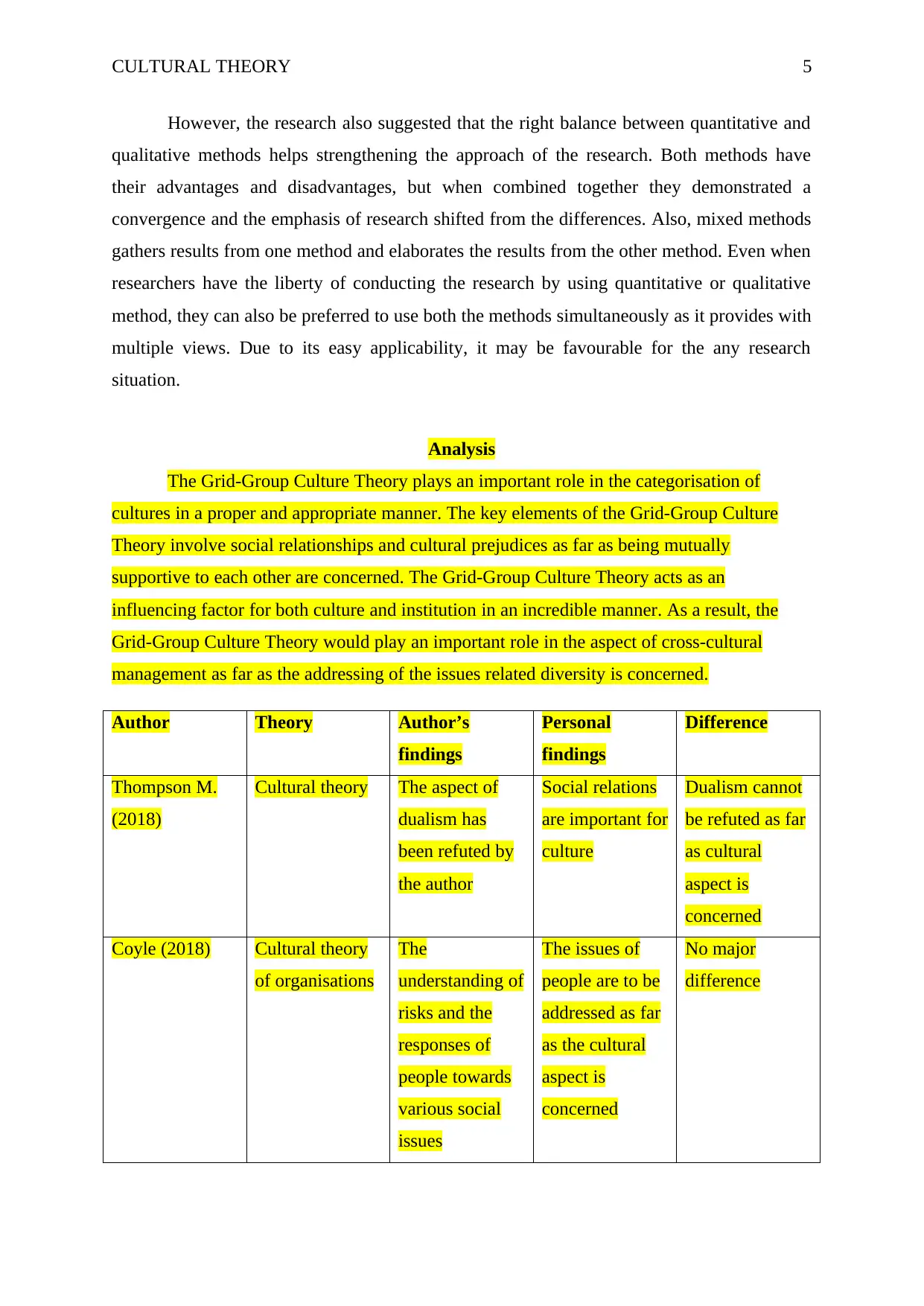
CULTURAL THEORY 5
However, the research also suggested that the right balance between quantitative and
qualitative methods helps strengthening the approach of the research. Both methods have
their advantages and disadvantages, but when combined together they demonstrated a
convergence and the emphasis of research shifted from the differences. Also, mixed methods
gathers results from one method and elaborates the results from the other method. Even when
researchers have the liberty of conducting the research by using quantitative or qualitative
method, they can also be preferred to use both the methods simultaneously as it provides with
multiple views. Due to its easy applicability, it may be favourable for the any research
situation.
Analysis
The Grid-Group Culture Theory plays an important role in the categorisation of
cultures in a proper and appropriate manner. The key elements of the Grid-Group Culture
Theory involve social relationships and cultural prejudices as far as being mutually
supportive to each other are concerned. The Grid-Group Culture Theory acts as an
influencing factor for both culture and institution in an incredible manner. As a result, the
Grid-Group Culture Theory would play an important role in the aspect of cross-cultural
management as far as the addressing of the issues related diversity is concerned.
Author Theory Author’s
findings
Personal
findings
Difference
Thompson M.
(2018)
Cultural theory The aspect of
dualism has
been refuted by
the author
Social relations
are important for
culture
Dualism cannot
be refuted as far
as cultural
aspect is
concerned
Coyle (2018) Cultural theory
of organisations
The
understanding of
risks and the
responses of
people towards
various social
issues
The issues of
people are to be
addressed as far
as the cultural
aspect is
concerned
No major
difference
However, the research also suggested that the right balance between quantitative and
qualitative methods helps strengthening the approach of the research. Both methods have
their advantages and disadvantages, but when combined together they demonstrated a
convergence and the emphasis of research shifted from the differences. Also, mixed methods
gathers results from one method and elaborates the results from the other method. Even when
researchers have the liberty of conducting the research by using quantitative or qualitative
method, they can also be preferred to use both the methods simultaneously as it provides with
multiple views. Due to its easy applicability, it may be favourable for the any research
situation.
Analysis
The Grid-Group Culture Theory plays an important role in the categorisation of
cultures in a proper and appropriate manner. The key elements of the Grid-Group Culture
Theory involve social relationships and cultural prejudices as far as being mutually
supportive to each other are concerned. The Grid-Group Culture Theory acts as an
influencing factor for both culture and institution in an incredible manner. As a result, the
Grid-Group Culture Theory would play an important role in the aspect of cross-cultural
management as far as the addressing of the issues related diversity is concerned.
Author Theory Author’s
findings
Personal
findings
Difference
Thompson M.
(2018)
Cultural theory The aspect of
dualism has
been refuted by
the author
Social relations
are important for
culture
Dualism cannot
be refuted as far
as cultural
aspect is
concerned
Coyle (2018) Cultural theory
of organisations
The
understanding of
risks and the
responses of
people towards
various social
issues
The issues of
people are to be
addressed as far
as the cultural
aspect is
concerned
No major
difference
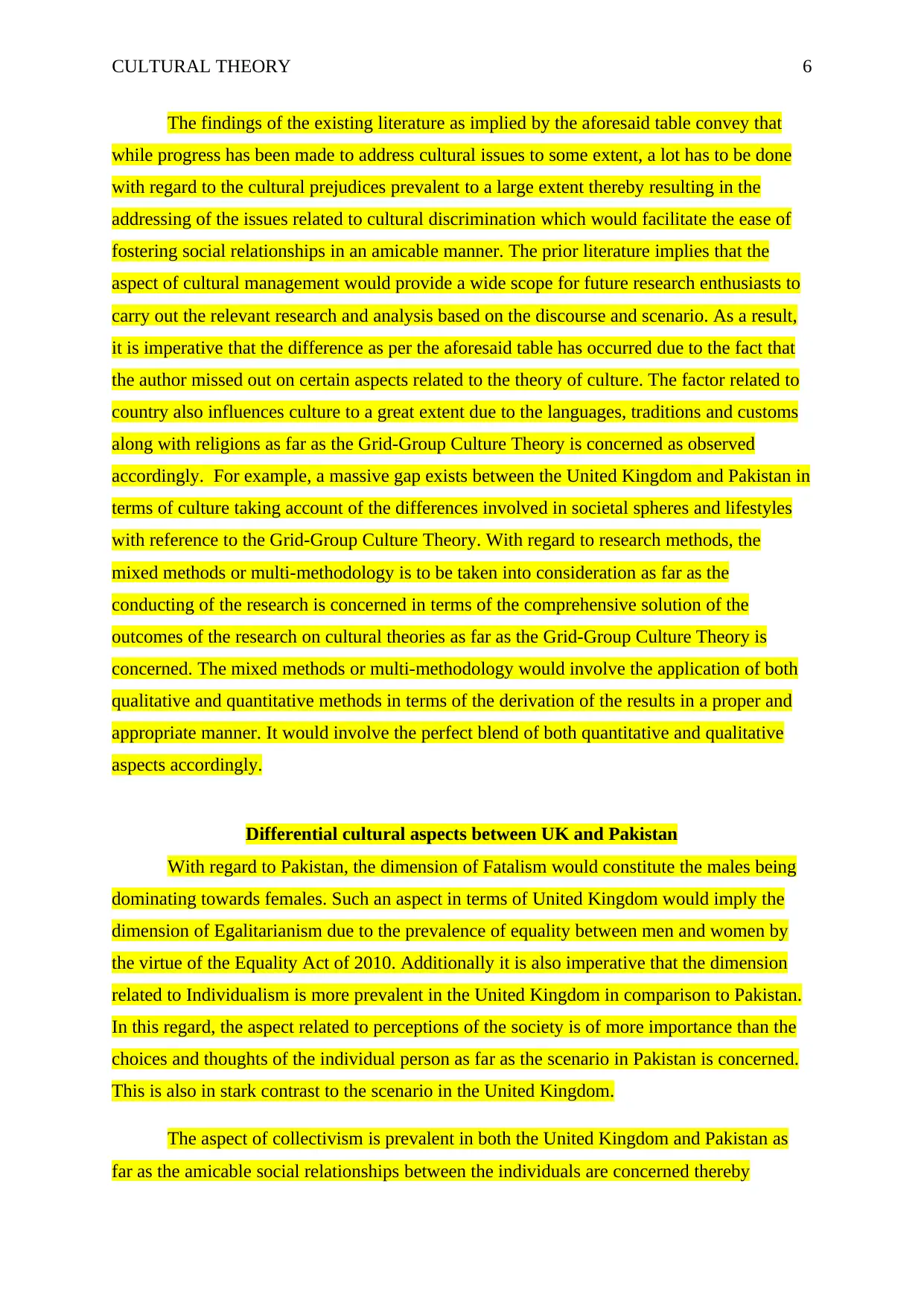
CULTURAL THEORY 6
The findings of the existing literature as implied by the aforesaid table convey that
while progress has been made to address cultural issues to some extent, a lot has to be done
with regard to the cultural prejudices prevalent to a large extent thereby resulting in the
addressing of the issues related to cultural discrimination which would facilitate the ease of
fostering social relationships in an amicable manner. The prior literature implies that the
aspect of cultural management would provide a wide scope for future research enthusiasts to
carry out the relevant research and analysis based on the discourse and scenario. As a result,
it is imperative that the difference as per the aforesaid table has occurred due to the fact that
the author missed out on certain aspects related to the theory of culture. The factor related to
country also influences culture to a great extent due to the languages, traditions and customs
along with religions as far as the Grid-Group Culture Theory is concerned as observed
accordingly. For example, a massive gap exists between the United Kingdom and Pakistan in
terms of culture taking account of the differences involved in societal spheres and lifestyles
with reference to the Grid-Group Culture Theory. With regard to research methods, the
mixed methods or multi-methodology is to be taken into consideration as far as the
conducting of the research is concerned in terms of the comprehensive solution of the
outcomes of the research on cultural theories as far as the Grid-Group Culture Theory is
concerned. The mixed methods or multi-methodology would involve the application of both
qualitative and quantitative methods in terms of the derivation of the results in a proper and
appropriate manner. It would involve the perfect blend of both quantitative and qualitative
aspects accordingly.
Differential cultural aspects between UK and Pakistan
With regard to Pakistan, the dimension of Fatalism would constitute the males being
dominating towards females. Such an aspect in terms of United Kingdom would imply the
dimension of Egalitarianism due to the prevalence of equality between men and women by
the virtue of the Equality Act of 2010. Additionally it is also imperative that the dimension
related to Individualism is more prevalent in the United Kingdom in comparison to Pakistan.
In this regard, the aspect related to perceptions of the society is of more importance than the
choices and thoughts of the individual person as far as the scenario in Pakistan is concerned.
This is also in stark contrast to the scenario in the United Kingdom.
The aspect of collectivism is prevalent in both the United Kingdom and Pakistan as
far as the amicable social relationships between the individuals are concerned thereby
The findings of the existing literature as implied by the aforesaid table convey that
while progress has been made to address cultural issues to some extent, a lot has to be done
with regard to the cultural prejudices prevalent to a large extent thereby resulting in the
addressing of the issues related to cultural discrimination which would facilitate the ease of
fostering social relationships in an amicable manner. The prior literature implies that the
aspect of cultural management would provide a wide scope for future research enthusiasts to
carry out the relevant research and analysis based on the discourse and scenario. As a result,
it is imperative that the difference as per the aforesaid table has occurred due to the fact that
the author missed out on certain aspects related to the theory of culture. The factor related to
country also influences culture to a great extent due to the languages, traditions and customs
along with religions as far as the Grid-Group Culture Theory is concerned as observed
accordingly. For example, a massive gap exists between the United Kingdom and Pakistan in
terms of culture taking account of the differences involved in societal spheres and lifestyles
with reference to the Grid-Group Culture Theory. With regard to research methods, the
mixed methods or multi-methodology is to be taken into consideration as far as the
conducting of the research is concerned in terms of the comprehensive solution of the
outcomes of the research on cultural theories as far as the Grid-Group Culture Theory is
concerned. The mixed methods or multi-methodology would involve the application of both
qualitative and quantitative methods in terms of the derivation of the results in a proper and
appropriate manner. It would involve the perfect blend of both quantitative and qualitative
aspects accordingly.
Differential cultural aspects between UK and Pakistan
With regard to Pakistan, the dimension of Fatalism would constitute the males being
dominating towards females. Such an aspect in terms of United Kingdom would imply the
dimension of Egalitarianism due to the prevalence of equality between men and women by
the virtue of the Equality Act of 2010. Additionally it is also imperative that the dimension
related to Individualism is more prevalent in the United Kingdom in comparison to Pakistan.
In this regard, the aspect related to perceptions of the society is of more importance than the
choices and thoughts of the individual person as far as the scenario in Pakistan is concerned.
This is also in stark contrast to the scenario in the United Kingdom.
The aspect of collectivism is prevalent in both the United Kingdom and Pakistan as
far as the amicable social relationships between the individuals are concerned thereby
⊘ This is a preview!⊘
Do you want full access?
Subscribe today to unlock all pages.

Trusted by 1+ million students worldwide
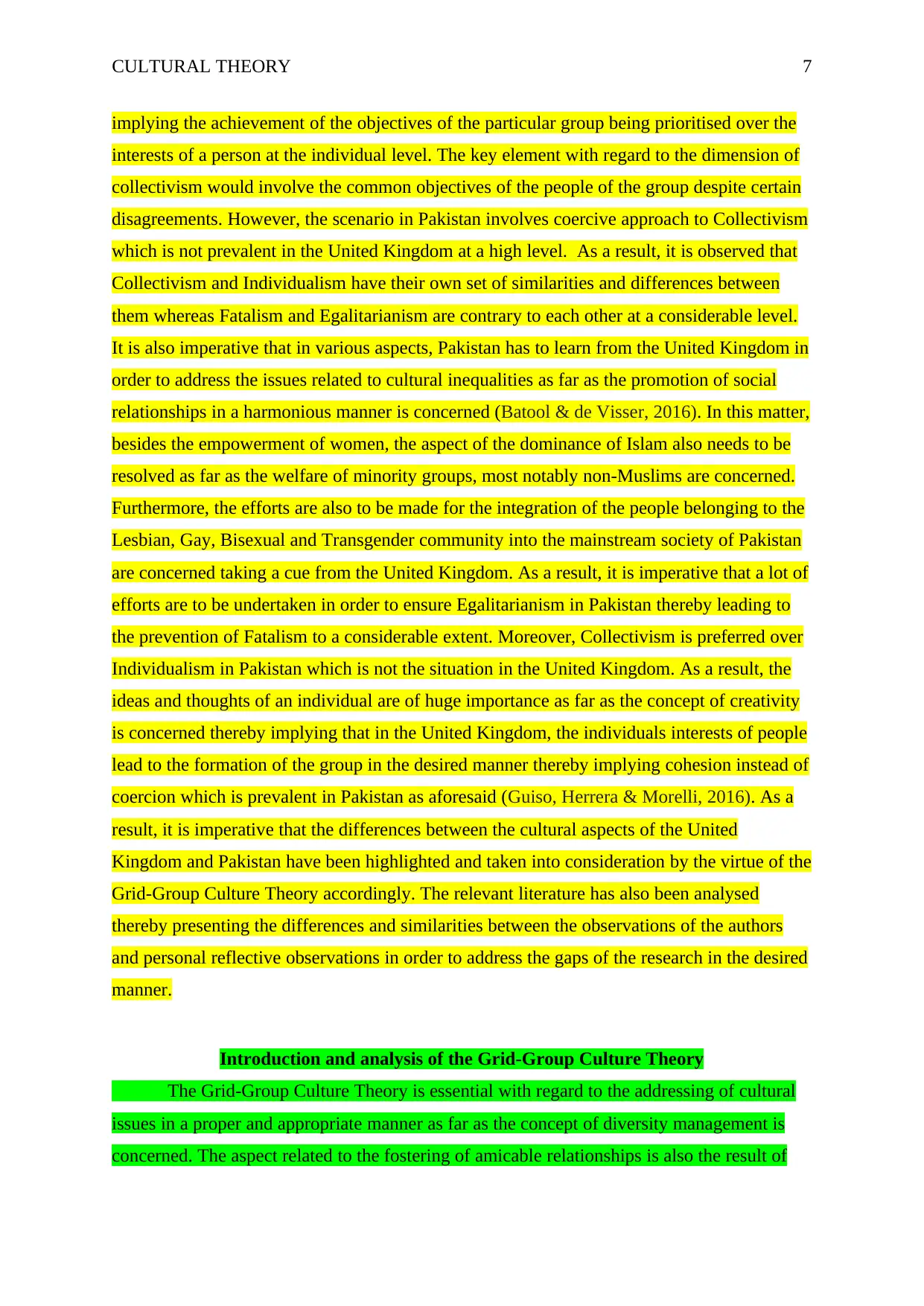
CULTURAL THEORY 7
implying the achievement of the objectives of the particular group being prioritised over the
interests of a person at the individual level. The key element with regard to the dimension of
collectivism would involve the common objectives of the people of the group despite certain
disagreements. However, the scenario in Pakistan involves coercive approach to Collectivism
which is not prevalent in the United Kingdom at a high level. As a result, it is observed that
Collectivism and Individualism have their own set of similarities and differences between
them whereas Fatalism and Egalitarianism are contrary to each other at a considerable level.
It is also imperative that in various aspects, Pakistan has to learn from the United Kingdom in
order to address the issues related to cultural inequalities as far as the promotion of social
relationships in a harmonious manner is concerned (Batool & de Visser, 2016). In this matter,
besides the empowerment of women, the aspect of the dominance of Islam also needs to be
resolved as far as the welfare of minority groups, most notably non-Muslims are concerned.
Furthermore, the efforts are also to be made for the integration of the people belonging to the
Lesbian, Gay, Bisexual and Transgender community into the mainstream society of Pakistan
are concerned taking a cue from the United Kingdom. As a result, it is imperative that a lot of
efforts are to be undertaken in order to ensure Egalitarianism in Pakistan thereby leading to
the prevention of Fatalism to a considerable extent. Moreover, Collectivism is preferred over
Individualism in Pakistan which is not the situation in the United Kingdom. As a result, the
ideas and thoughts of an individual are of huge importance as far as the concept of creativity
is concerned thereby implying that in the United Kingdom, the individuals interests of people
lead to the formation of the group in the desired manner thereby implying cohesion instead of
coercion which is prevalent in Pakistan as aforesaid (Guiso, Herrera & Morelli, 2016). As a
result, it is imperative that the differences between the cultural aspects of the United
Kingdom and Pakistan have been highlighted and taken into consideration by the virtue of the
Grid-Group Culture Theory accordingly. The relevant literature has also been analysed
thereby presenting the differences and similarities between the observations of the authors
and personal reflective observations in order to address the gaps of the research in the desired
manner.
Introduction and analysis of the Grid-Group Culture Theory
The Grid-Group Culture Theory is essential with regard to the addressing of cultural
issues in a proper and appropriate manner as far as the concept of diversity management is
concerned. The aspect related to the fostering of amicable relationships is also the result of
implying the achievement of the objectives of the particular group being prioritised over the
interests of a person at the individual level. The key element with regard to the dimension of
collectivism would involve the common objectives of the people of the group despite certain
disagreements. However, the scenario in Pakistan involves coercive approach to Collectivism
which is not prevalent in the United Kingdom at a high level. As a result, it is observed that
Collectivism and Individualism have their own set of similarities and differences between
them whereas Fatalism and Egalitarianism are contrary to each other at a considerable level.
It is also imperative that in various aspects, Pakistan has to learn from the United Kingdom in
order to address the issues related to cultural inequalities as far as the promotion of social
relationships in a harmonious manner is concerned (Batool & de Visser, 2016). In this matter,
besides the empowerment of women, the aspect of the dominance of Islam also needs to be
resolved as far as the welfare of minority groups, most notably non-Muslims are concerned.
Furthermore, the efforts are also to be made for the integration of the people belonging to the
Lesbian, Gay, Bisexual and Transgender community into the mainstream society of Pakistan
are concerned taking a cue from the United Kingdom. As a result, it is imperative that a lot of
efforts are to be undertaken in order to ensure Egalitarianism in Pakistan thereby leading to
the prevention of Fatalism to a considerable extent. Moreover, Collectivism is preferred over
Individualism in Pakistan which is not the situation in the United Kingdom. As a result, the
ideas and thoughts of an individual are of huge importance as far as the concept of creativity
is concerned thereby implying that in the United Kingdom, the individuals interests of people
lead to the formation of the group in the desired manner thereby implying cohesion instead of
coercion which is prevalent in Pakistan as aforesaid (Guiso, Herrera & Morelli, 2016). As a
result, it is imperative that the differences between the cultural aspects of the United
Kingdom and Pakistan have been highlighted and taken into consideration by the virtue of the
Grid-Group Culture Theory accordingly. The relevant literature has also been analysed
thereby presenting the differences and similarities between the observations of the authors
and personal reflective observations in order to address the gaps of the research in the desired
manner.
Introduction and analysis of the Grid-Group Culture Theory
The Grid-Group Culture Theory is essential with regard to the addressing of cultural
issues in a proper and appropriate manner as far as the concept of diversity management is
concerned. The aspect related to the fostering of amicable relationships is also the result of
Paraphrase This Document
Need a fresh take? Get an instant paraphrase of this document with our AI Paraphraser

CULTURAL THEORY 8
the application of the Grid-Group Culture Theory (Maleki & Hendriks, 2015). Additionally,
the influence of various cultures and institutions is also the result of the implementation of
the Grid-Group Culture Theory in a proper and appropriate manner accordingly. The concept
related to cross- cultural management would also be facilitated as a result of the Grid-Group
Culture Theory (Chai, 2018). As a result, the issues related to cultural gap can be addressed
by the virtue of the Grid-Group Culture Theory in an effective and efficient manner as far as
integration into the society in the desired manner is concerned without any prejudicial views
and opinions. The various dimensions of culture can be implied as a result of the Grid-Group
Culture Theory in the desired manner thereby implying the various societal spheres in terms
of culture in an incredible manner. As a result, the concept of cultural understanding would
be implied as a result of the application of the Grid-Group Culture Theory. It would help in
the elimination of cultural bias to a considerable extent as far as the reduction of inequalities
is concerned with regard to the societal views and apprehensions. Furthermore, the Grid-
Group Culture Theory also helps in the steps and measures to be undertaken for the
improvements to be made in terms of the overall welfare of the society thereby leading to the
comprehensive results in relation to culture. The key thing related to the Grid-Group Culture
Theory is the cohesion of the different groups in an incredible manner with any issues. The
aspects of fatalism and egalitarianism are completely different form each other as implied by
the Grid-Group Culture Theory since fatalism implies the dominance of one group over
another whereas egalitarianism implies the existence of equality amongst the groups
(Lockhart, 2018). As a result, it is imperative that fatalism results in the disastrous aspect of
the society as far as the rise of conflicts amongst groups is concerned. It also leads to the
various kinds of movements to press for the demand of equality in the society as far as
egalitarianism is concerned. Additionally, there are certain similarities and differences
prevalent between the aspects of collectivism and individualism as far as the basic tenets of
the Grid-Group Culture Theory are concerned. The aspect of collectivism implies the
objectives of the group in common and the aspect of individualism implies the aims and
objectives of an individual person. The aims and objectives of two or more individuals imply
the similarity of collectivism and individualism thereby implying that the people in the group
are not forced to act as far as the coercive approach is concerned (Hood, 2016). It would help
implementation of the Grid-Group Culture Theory in the desired manner taking account of
the circumstances of the situation in question. The fostering of amicable relationships
amongst people thereby leading to the formation of the different kinds of groups is one of the
key things related to the Grid-Group Culture Theory. Such an aspect implies the prevention
the application of the Grid-Group Culture Theory (Maleki & Hendriks, 2015). Additionally,
the influence of various cultures and institutions is also the result of the implementation of
the Grid-Group Culture Theory in a proper and appropriate manner accordingly. The concept
related to cross- cultural management would also be facilitated as a result of the Grid-Group
Culture Theory (Chai, 2018). As a result, the issues related to cultural gap can be addressed
by the virtue of the Grid-Group Culture Theory in an effective and efficient manner as far as
integration into the society in the desired manner is concerned without any prejudicial views
and opinions. The various dimensions of culture can be implied as a result of the Grid-Group
Culture Theory in the desired manner thereby implying the various societal spheres in terms
of culture in an incredible manner. As a result, the concept of cultural understanding would
be implied as a result of the application of the Grid-Group Culture Theory. It would help in
the elimination of cultural bias to a considerable extent as far as the reduction of inequalities
is concerned with regard to the societal views and apprehensions. Furthermore, the Grid-
Group Culture Theory also helps in the steps and measures to be undertaken for the
improvements to be made in terms of the overall welfare of the society thereby leading to the
comprehensive results in relation to culture. The key thing related to the Grid-Group Culture
Theory is the cohesion of the different groups in an incredible manner with any issues. The
aspects of fatalism and egalitarianism are completely different form each other as implied by
the Grid-Group Culture Theory since fatalism implies the dominance of one group over
another whereas egalitarianism implies the existence of equality amongst the groups
(Lockhart, 2018). As a result, it is imperative that fatalism results in the disastrous aspect of
the society as far as the rise of conflicts amongst groups is concerned. It also leads to the
various kinds of movements to press for the demand of equality in the society as far as
egalitarianism is concerned. Additionally, there are certain similarities and differences
prevalent between the aspects of collectivism and individualism as far as the basic tenets of
the Grid-Group Culture Theory are concerned. The aspect of collectivism implies the
objectives of the group in common and the aspect of individualism implies the aims and
objectives of an individual person. The aims and objectives of two or more individuals imply
the similarity of collectivism and individualism thereby implying that the people in the group
are not forced to act as far as the coercive approach is concerned (Hood, 2016). It would help
implementation of the Grid-Group Culture Theory in the desired manner taking account of
the circumstances of the situation in question. The fostering of amicable relationships
amongst people thereby leading to the formation of the different kinds of groups is one of the
key things related to the Grid-Group Culture Theory. Such an aspect implies the prevention

CULTURAL THEORY 9
of the possible conflicts amongst people based on the prejudicial differences in terms of
culture. The aspect of multiculturalism is also a result of egalitarianism as far as the
addressing of the issues related to fatalism is concerned thereby promoting diversity in the
society to a significant extent as far as inclusiveness is concerned. In this regard, the aspect of
racism is vehemently opposed to a large extent along with the emancipation and upliftment of
people belonging to the down trodden groups of the society as far as the ascribed and
achieved aspects of caste and class respectively are concerned (van der Linden, 2016). As a
result, it is imperative that in order to ensure the aspect of orderliness in the society, the
concept of egalitarianism is to be taken into consideration thereby implying cohesiveness
amongst all groups of people. In this matter, the aspect of natural justice would have an
essential role to play as far as the application of principles related to equity and fairness are
concerned in terms of the maintenance of the aspect of egalitarianism with regard to the Grid-
Group Culture Theory. The activities to be performed by the groups in question are to be
stipulated and allocated in advance in order to avoid the issues in future as far as the
management of the resources is concerned. Besides cultures, the various kinds of institutions
are also influenced by the Grid-Group Culture Theory to a significant level as far as their
overall functioning in an incredible manner is concerned. The Grid-Group Culture Theory
further asserts that the hierarchical aspect needs to be followed in terms of the management
of the resources as aforesaid at higher levels thereby implying the aspect of collectivism in a
cohesive manner as far as the desired results are concerned by the virtue of working in groups
in a co-operative manner on a mutual basis without any hassles or obstacles. As a result, it is
inferred that the hindrances and obstacles pertaining to cultural equality would be addressed
in an effective and efficient manner by the virtue of the implementation of the Grid-Group
Culture Theory thereby leading to the elimination of the restrictions and limitations along
with the barriers imposed in terms of culture thereby leading to a possible pathway for the
removal of dogmas and unjustified cultural practices in the desired manner. However, it is
also observed by the analysis of the Grid-Group Culture Theory that the detrimental effect
towards to the culture are to be avoided as far as the protection of certain kinds of rituals and
traditions are concerned. It is also observed that considering the recent trends, the Grid-Group
Culture Theory has gained a huge importance as far as the comparison of the cultures of two
or more countries are concerned thereby implying the viability of such theory in the long run.
of the possible conflicts amongst people based on the prejudicial differences in terms of
culture. The aspect of multiculturalism is also a result of egalitarianism as far as the
addressing of the issues related to fatalism is concerned thereby promoting diversity in the
society to a significant extent as far as inclusiveness is concerned. In this regard, the aspect of
racism is vehemently opposed to a large extent along with the emancipation and upliftment of
people belonging to the down trodden groups of the society as far as the ascribed and
achieved aspects of caste and class respectively are concerned (van der Linden, 2016). As a
result, it is imperative that in order to ensure the aspect of orderliness in the society, the
concept of egalitarianism is to be taken into consideration thereby implying cohesiveness
amongst all groups of people. In this matter, the aspect of natural justice would have an
essential role to play as far as the application of principles related to equity and fairness are
concerned in terms of the maintenance of the aspect of egalitarianism with regard to the Grid-
Group Culture Theory. The activities to be performed by the groups in question are to be
stipulated and allocated in advance in order to avoid the issues in future as far as the
management of the resources is concerned. Besides cultures, the various kinds of institutions
are also influenced by the Grid-Group Culture Theory to a significant level as far as their
overall functioning in an incredible manner is concerned. The Grid-Group Culture Theory
further asserts that the hierarchical aspect needs to be followed in terms of the management
of the resources as aforesaid at higher levels thereby implying the aspect of collectivism in a
cohesive manner as far as the desired results are concerned by the virtue of working in groups
in a co-operative manner on a mutual basis without any hassles or obstacles. As a result, it is
inferred that the hindrances and obstacles pertaining to cultural equality would be addressed
in an effective and efficient manner by the virtue of the implementation of the Grid-Group
Culture Theory thereby leading to the elimination of the restrictions and limitations along
with the barriers imposed in terms of culture thereby leading to a possible pathway for the
removal of dogmas and unjustified cultural practices in the desired manner. However, it is
also observed by the analysis of the Grid-Group Culture Theory that the detrimental effect
towards to the culture are to be avoided as far as the protection of certain kinds of rituals and
traditions are concerned. It is also observed that considering the recent trends, the Grid-Group
Culture Theory has gained a huge importance as far as the comparison of the cultures of two
or more countries are concerned thereby implying the viability of such theory in the long run.
⊘ This is a preview!⊘
Do you want full access?
Subscribe today to unlock all pages.

Trusted by 1+ million students worldwide

CULTURAL THEORY 10
Thread analysis
The table as aforesaid implies the differences and similarities between the findings of
authors and personal findings accordingly. The findings imply that a lot has to be put into
action with regard to the addressing of the issues related to cultural prejudices to a huge
extent. The findings also identify certain kinds of gaps in the literature which have been
addressed by the virtue of personal findings to a certain extent as far as the gap analysis is
concerned in course of the review of the relevant literature. In order to address the gaps, the
importance of social relationships has been taken into consideration which has been done
away with by the author Thompson who had implied the vehement opposition of the idea of
dualism in terms of society and culture as far as the application of the Grid-Group Culture
Theory is concerned (Berger, 2016). It would help in the elimination of the cultural
prejudices prevalent in various forms taking account of the scenario of the society in question
as far as the traditions and customs are concerned along with the practices which are in
contravention to the aspect of human dignity. The findings also imply that the management of
culture would help in the providing of an incredible pathway towards further research and
analysis in a detailed manner as far as the role to be played by the future research enthusiasts
and analysts are concerned. The table also implies that the similarity is in terms of the
addressing of the cultural risks and issues in the desired manner as far as the fostering and
maintenance of social relationships is concerned as per the comparative analysis between the
personal findings and the findings of the author with regard to the prior relevant literature.
The gaps also imply the laxity in the research and analysis of the author in terms of certain
aspects of culture as far as the elimination of various kinds of cultural biases and prejudices
are concerned in the desired manner thereby leading to the comprehensive outcomes as far as
the benefits of the society is concerned. It is further imperative from the table that while the
Grid-Group Culture Theory has similarities with the Cultural Theory of organisations
postulated by Coyle, it is different from the Cultural Theory postulated by Thompson
(Simmons, 2016). The main reason for the difference is the views of the author which are not
comprehensive in nature thereby implying the author has failed to appreciate the aspect of
culture as far as the positive impact of culture is concerned. The differences and similarities
as implied by the table may also be as a result of the scenario of the countries in question as a
result of the conducting of a comparative analysis between two or more countries in terms of
the cultural aspect of the countries in question which not only implies religion but also
highlight the aspect of the kinds of people prevalent in the society along with the traditions
and customs of the countries. Additionally, it would also imply the modus operand of the
Thread analysis
The table as aforesaid implies the differences and similarities between the findings of
authors and personal findings accordingly. The findings imply that a lot has to be put into
action with regard to the addressing of the issues related to cultural prejudices to a huge
extent. The findings also identify certain kinds of gaps in the literature which have been
addressed by the virtue of personal findings to a certain extent as far as the gap analysis is
concerned in course of the review of the relevant literature. In order to address the gaps, the
importance of social relationships has been taken into consideration which has been done
away with by the author Thompson who had implied the vehement opposition of the idea of
dualism in terms of society and culture as far as the application of the Grid-Group Culture
Theory is concerned (Berger, 2016). It would help in the elimination of the cultural
prejudices prevalent in various forms taking account of the scenario of the society in question
as far as the traditions and customs are concerned along with the practices which are in
contravention to the aspect of human dignity. The findings also imply that the management of
culture would help in the providing of an incredible pathway towards further research and
analysis in a detailed manner as far as the role to be played by the future research enthusiasts
and analysts are concerned. The table also implies that the similarity is in terms of the
addressing of the cultural risks and issues in the desired manner as far as the fostering and
maintenance of social relationships is concerned as per the comparative analysis between the
personal findings and the findings of the author with regard to the prior relevant literature.
The gaps also imply the laxity in the research and analysis of the author in terms of certain
aspects of culture as far as the elimination of various kinds of cultural biases and prejudices
are concerned in the desired manner thereby leading to the comprehensive outcomes as far as
the benefits of the society is concerned. It is further imperative from the table that while the
Grid-Group Culture Theory has similarities with the Cultural Theory of organisations
postulated by Coyle, it is different from the Cultural Theory postulated by Thompson
(Simmons, 2016). The main reason for the difference is the views of the author which are not
comprehensive in nature thereby implying the author has failed to appreciate the aspect of
culture as far as the positive impact of culture is concerned. The differences and similarities
as implied by the table may also be as a result of the scenario of the countries in question as a
result of the conducting of a comparative analysis between two or more countries in terms of
the cultural aspect of the countries in question which not only implies religion but also
highlight the aspect of the kinds of people prevalent in the society along with the traditions
and customs of the countries. Additionally, it would also imply the modus operand of the
Paraphrase This Document
Need a fresh take? Get an instant paraphrase of this document with our AI Paraphraser

CULTURAL THEORY 11
countries as a whole as far as the facilitation of the ease of highlighting the similarities and
differences concerned. It is also imperative that further research would help in the
understanding of the similarities and differences between the personal findings and the
findings of the relevant literature as far as the views and opinions of the authors are
concerned in connection with the personal opinions implying the analysis in terms of the
similarities and differences in a proper and appropriate manner as far as the disciplines
related to culture are concerned. As a result, the laxity in research is to be addressed at the
earliest as far as the inclusion of the details in a proper and appropriate manner is concerned
as implied by the aforesaid table. It would also help in the understanding of the aspects
missed by the author in question as far as their relevancy and validity are concerned with
regard to the aspect of positive impact in the long run as far as culture is concerned. The steps
and measures to be undertaken in order to address the differences would also be implied as a
result of further research thereby implying cultural equality in the long run at the global level
in additional to the protection of the culture at the local and national levels accordingly. The
additional theories as postulated by the concerned authors would also be implied if extensive
research in an in-depth manner is undertaken thereby stating the similarities and differences
of the theories of the authors along with the general aspects of the Grid-Group Culture
Theory in a proper and appropriate manner. It would help in the critical analysis of the Grid-
Group Culture Theory thereby resulting in the desired outcomes which would provide an
appropriate guidance to a layman about the rationale behind such kinds of differences
accordingly. As a result, perceptions and apprehensions would be formed amongst the readers
in the desired manner. The various aspects of the theories would be taken into consideration
based on the findings of the authors along with the personal findings thereby implying the
points of similarities and differences in an effective and efficient manner. As a result, it
would enable the analysis of the Grid-Group Culture Theory in a proper manner thereby
resulting in the positive outcomes as far as the comparative analysis is concerned. The
importance of the Grid-Group Culture Theory would also be taken into consideration as far as
its applicability in the long run is concerned taking account tof the trends off late at the global
level thereby presenting the cultural prejudices between countries a s a result of the
comparative analysis.
countries as a whole as far as the facilitation of the ease of highlighting the similarities and
differences concerned. It is also imperative that further research would help in the
understanding of the similarities and differences between the personal findings and the
findings of the relevant literature as far as the views and opinions of the authors are
concerned in connection with the personal opinions implying the analysis in terms of the
similarities and differences in a proper and appropriate manner as far as the disciplines
related to culture are concerned. As a result, the laxity in research is to be addressed at the
earliest as far as the inclusion of the details in a proper and appropriate manner is concerned
as implied by the aforesaid table. It would also help in the understanding of the aspects
missed by the author in question as far as their relevancy and validity are concerned with
regard to the aspect of positive impact in the long run as far as culture is concerned. The steps
and measures to be undertaken in order to address the differences would also be implied as a
result of further research thereby implying cultural equality in the long run at the global level
in additional to the protection of the culture at the local and national levels accordingly. The
additional theories as postulated by the concerned authors would also be implied if extensive
research in an in-depth manner is undertaken thereby stating the similarities and differences
of the theories of the authors along with the general aspects of the Grid-Group Culture
Theory in a proper and appropriate manner. It would help in the critical analysis of the Grid-
Group Culture Theory thereby resulting in the desired outcomes which would provide an
appropriate guidance to a layman about the rationale behind such kinds of differences
accordingly. As a result, perceptions and apprehensions would be formed amongst the readers
in the desired manner. The various aspects of the theories would be taken into consideration
based on the findings of the authors along with the personal findings thereby implying the
points of similarities and differences in an effective and efficient manner. As a result, it
would enable the analysis of the Grid-Group Culture Theory in a proper manner thereby
resulting in the positive outcomes as far as the comparative analysis is concerned. The
importance of the Grid-Group Culture Theory would also be taken into consideration as far as
its applicability in the long run is concerned taking account tof the trends off late at the global
level thereby presenting the cultural prejudices between countries a s a result of the
comparative analysis.
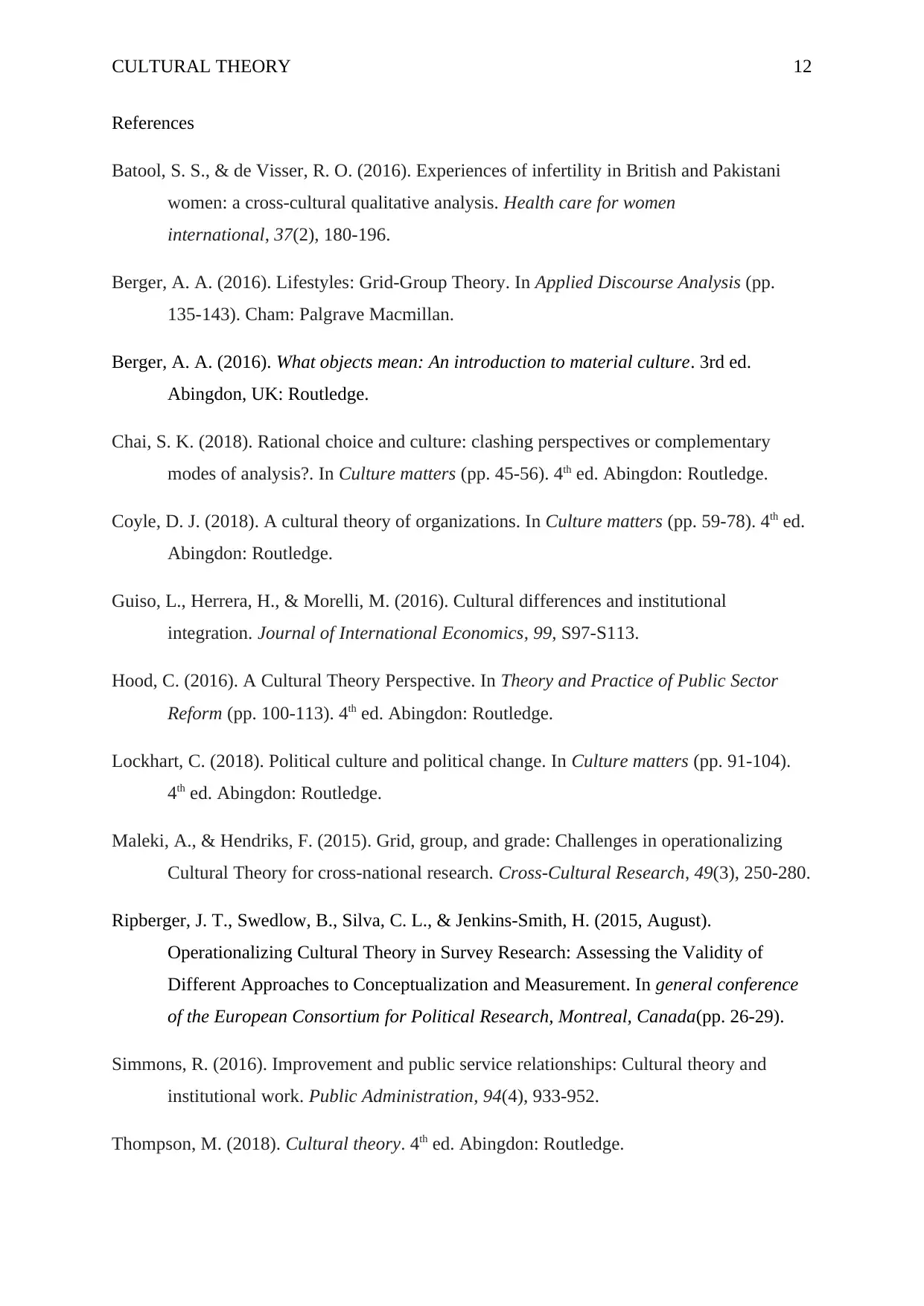
CULTURAL THEORY 12
References
Batool, S. S., & de Visser, R. O. (2016). Experiences of infertility in British and Pakistani
women: a cross-cultural qualitative analysis. Health care for women
international, 37(2), 180-196.
Berger, A. A. (2016). Lifestyles: Grid-Group Theory. In Applied Discourse Analysis (pp.
135-143). Cham: Palgrave Macmillan.
Berger, A. A. (2016). What objects mean: An introduction to material culture. 3rd ed.
Abingdon, UK: Routledge.
Chai, S. K. (2018). Rational choice and culture: clashing perspectives or complementary
modes of analysis?. In Culture matters (pp. 45-56). 4th ed. Abingdon: Routledge.
Coyle, D. J. (2018). A cultural theory of organizations. In Culture matters (pp. 59-78). 4th ed.
Abingdon: Routledge.
Guiso, L., Herrera, H., & Morelli, M. (2016). Cultural differences and institutional
integration. Journal of International Economics, 99, S97-S113.
Hood, C. (2016). A Cultural Theory Perspective. In Theory and Practice of Public Sector
Reform (pp. 100-113). 4th ed. Abingdon: Routledge.
Lockhart, C. (2018). Political culture and political change. In Culture matters (pp. 91-104).
4th ed. Abingdon: Routledge.
Maleki, A., & Hendriks, F. (2015). Grid, group, and grade: Challenges in operationalizing
Cultural Theory for cross-national research. Cross-Cultural Research, 49(3), 250-280.
Ripberger, J. T., Swedlow, B., Silva, C. L., & Jenkins-Smith, H. (2015, August).
Operationalizing Cultural Theory in Survey Research: Assessing the Validity of
Different Approaches to Conceptualization and Measurement. In general conference
of the European Consortium for Political Research, Montreal, Canada(pp. 26-29).
Simmons, R. (2016). Improvement and public service relationships: Cultural theory and
institutional work. Public Administration, 94(4), 933-952.
Thompson, M. (2018). Cultural theory. 4th ed. Abingdon: Routledge.
References
Batool, S. S., & de Visser, R. O. (2016). Experiences of infertility in British and Pakistani
women: a cross-cultural qualitative analysis. Health care for women
international, 37(2), 180-196.
Berger, A. A. (2016). Lifestyles: Grid-Group Theory. In Applied Discourse Analysis (pp.
135-143). Cham: Palgrave Macmillan.
Berger, A. A. (2016). What objects mean: An introduction to material culture. 3rd ed.
Abingdon, UK: Routledge.
Chai, S. K. (2018). Rational choice and culture: clashing perspectives or complementary
modes of analysis?. In Culture matters (pp. 45-56). 4th ed. Abingdon: Routledge.
Coyle, D. J. (2018). A cultural theory of organizations. In Culture matters (pp. 59-78). 4th ed.
Abingdon: Routledge.
Guiso, L., Herrera, H., & Morelli, M. (2016). Cultural differences and institutional
integration. Journal of International Economics, 99, S97-S113.
Hood, C. (2016). A Cultural Theory Perspective. In Theory and Practice of Public Sector
Reform (pp. 100-113). 4th ed. Abingdon: Routledge.
Lockhart, C. (2018). Political culture and political change. In Culture matters (pp. 91-104).
4th ed. Abingdon: Routledge.
Maleki, A., & Hendriks, F. (2015). Grid, group, and grade: Challenges in operationalizing
Cultural Theory for cross-national research. Cross-Cultural Research, 49(3), 250-280.
Ripberger, J. T., Swedlow, B., Silva, C. L., & Jenkins-Smith, H. (2015, August).
Operationalizing Cultural Theory in Survey Research: Assessing the Validity of
Different Approaches to Conceptualization and Measurement. In general conference
of the European Consortium for Political Research, Montreal, Canada(pp. 26-29).
Simmons, R. (2016). Improvement and public service relationships: Cultural theory and
institutional work. Public Administration, 94(4), 933-952.
Thompson, M. (2018). Cultural theory. 4th ed. Abingdon: Routledge.
⊘ This is a preview!⊘
Do you want full access?
Subscribe today to unlock all pages.

Trusted by 1+ million students worldwide
1 out of 13
Related Documents
Your All-in-One AI-Powered Toolkit for Academic Success.
+13062052269
info@desklib.com
Available 24*7 on WhatsApp / Email
![[object Object]](/_next/static/media/star-bottom.7253800d.svg)
Unlock your academic potential
Copyright © 2020–2025 A2Z Services. All Rights Reserved. Developed and managed by ZUCOL.





